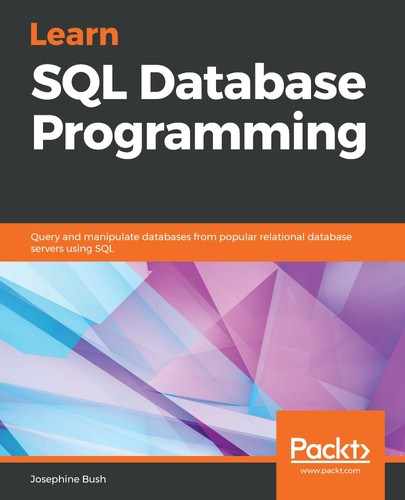- By listing the distinct values in a table.
- By querying for NULL values in a table.
- By querying the table with a GROUP BY and a HAVING count(*) > 2.
- Acquaint yourself with the data and create a data dictionary.
- A document that helps you to understand what is in your database.
- First, you will need to install a Python plugin into your MySQL Workbench installation, then create an ERD. Next, you can use the Python plugin to create the data dictionary to paste into a text or markdown editor of your choice.
- They help search for string patterns in your data.
- Matches the beginning of a string.
- Matches any of the patterns specified.
- Yes. WHERE column REGEXP '^[abc].{3}on$'
- Title Page
- Copyright and Credits
- About Packt
- Contributors
- Preface
- Section 1: Database Fundamentals
- Introduction to Relational Database Management Systems
- Installing and Using MySQL Workbench
- Understanding Data Types
- Designing and Creating a Database
- Technical requirements
- Creating a database
- Understanding table relationships
- Creating a table in the database
- Understanding indexes
- Summary 
- Further reading
- Questions
- Importing and Exporting Data
- Section 2: Basic SQL Querying
- Querying a Single Table
- Technical requirements
- Using the SELECT statement and FROM clause
- Understanding the SELECT statement and the FROM clause
- Learning the correct order of other clauses you can use with SELECT
- Understanding the different ways to query with a SELECT statement
- Learning how to use column aliases
- Using the USE statement
- Learning how to use the DISTINCT clause 
- Learning how to use the LIMIT clause
- Learning how to save a SQL query to a file
- Learning how to open a SQL file
- Learning how to add comments to your SQL code
- Using the WHERE clause
- Using the ORDER BY clause
- Using indexes with your queries 
- Summary
- Questions
- Further reading 
- Querying Multiple Tables
- Technical requirements
- Understanding joins 
- Using INNER JOIN 
- Using OUTER JOIN 
- Using advanced joins 
- Understanding set theory
- Using indexes with your queries 
- Summary 
- Questions
- Further reading 
- Modifying Data and Table Structures
- Section 3: Advanced SQL Querying
- Working with Expressions
- Technical requirements
- Using expressions
- Using statistical functions
- Using generated columns 
- Summary 
- Questions 
- Further reading 
- Grouping and Summarizing Data
- Advanced Querying Techniques
- Technical requirements
- Using subqueries
- Understanding the different types of subqueries and their usage
- Using non-correlated subqueries 
- Using a non-correlated subquery in the WHERE clause
- Using a non-correlated subquery in the SELECT clause
- Using a non-correlated subquery in the FROM clause
- Using INSERT, UPDATE, and DELETE with non-correlated subqueries
- Differences between non-correlated subqueries in other relational database management systems (RDMSes)
- Using correlated subqueries 
- Using non-correlated subqueries 
- Understanding the different types of subqueries and their usage
- Using common table expressions
- Using query hints and transaction isolation levels
- Summary 
- Questions 
- Further reading 
- Programmable Objects
- Technical requirements
- Creating and using views
- Creating and using variables
- Creating and using stored procedures
- Creating and using functions
- Creating and using triggers
- Creating and using temporary tables
- Summary 
- Questions
- Further reading 
- Section 4: Presenting Your Findings
- Exploring and Processing Your Data
- Technical requirements
- Exploring your dataset
- Processing your dataset
- Summary 
- Questions 
- Telling a Story with Your Data
- Section 5: SQL Best Practices
- Best Practices for Designing and Querying
- SQL Appendix
- Assessments
- Other Books You May Enjoy
Chapter 13
-
No Comment
..................Content has been hidden....................
You can't read the all page of ebook, please click here login for view all page.
